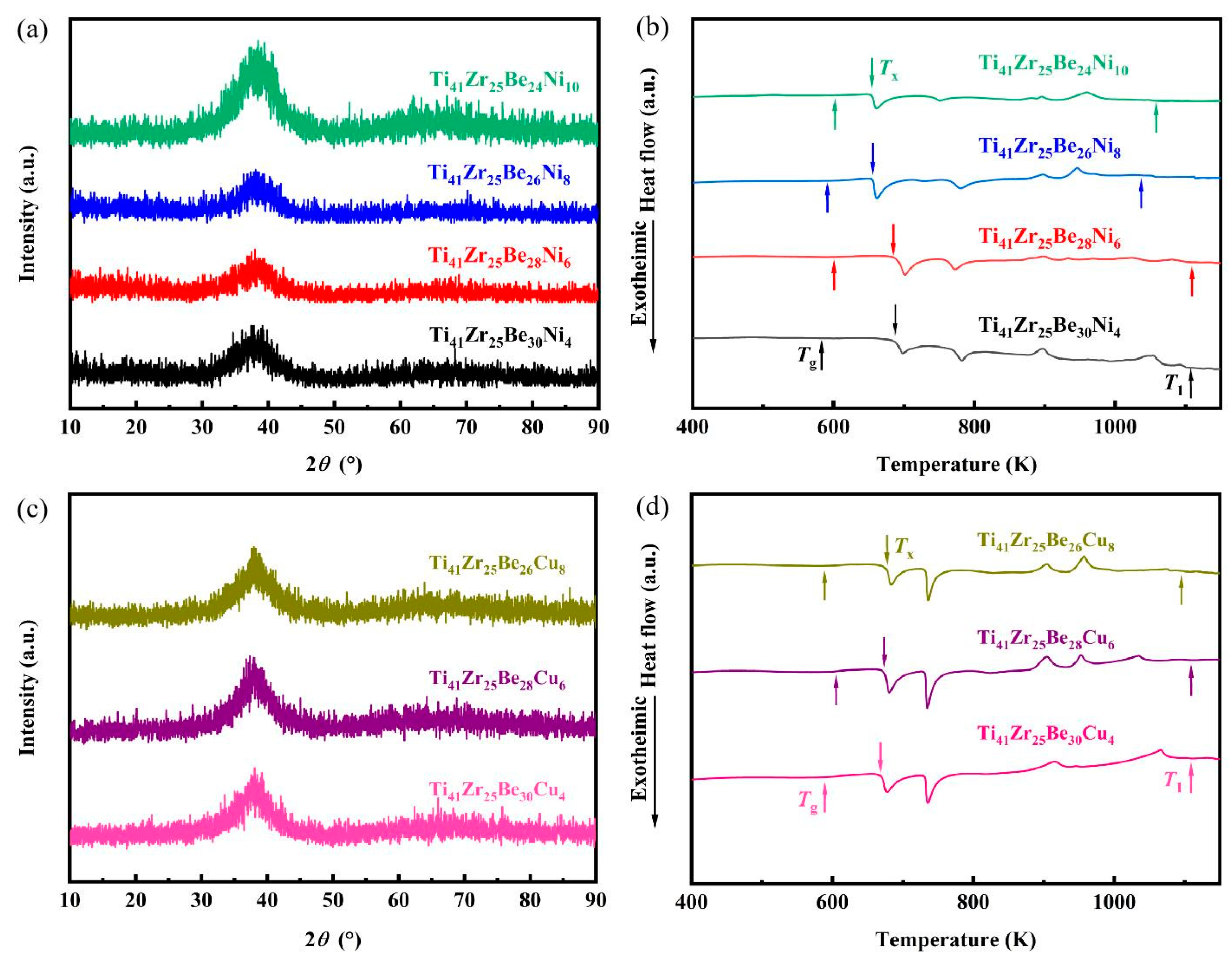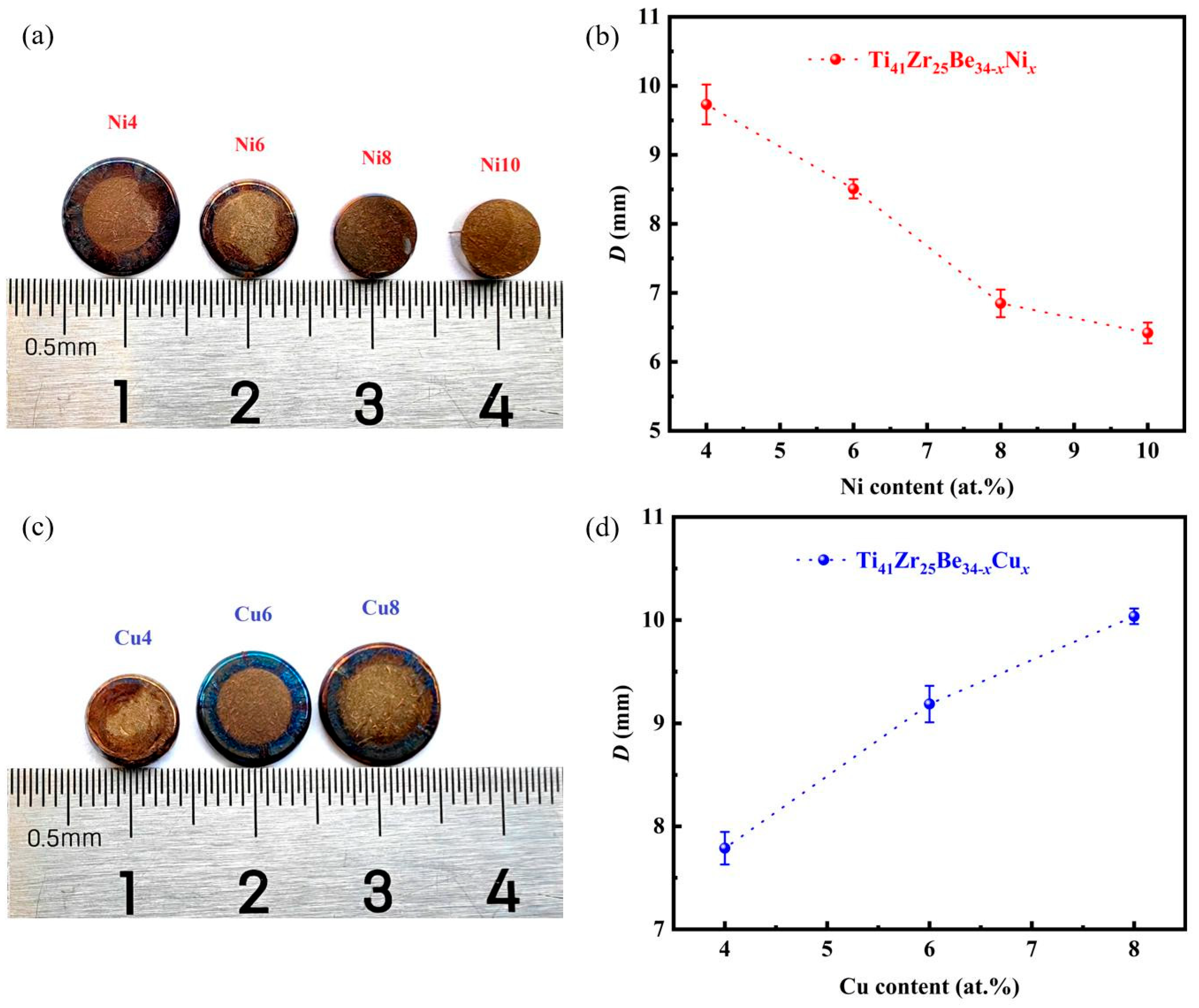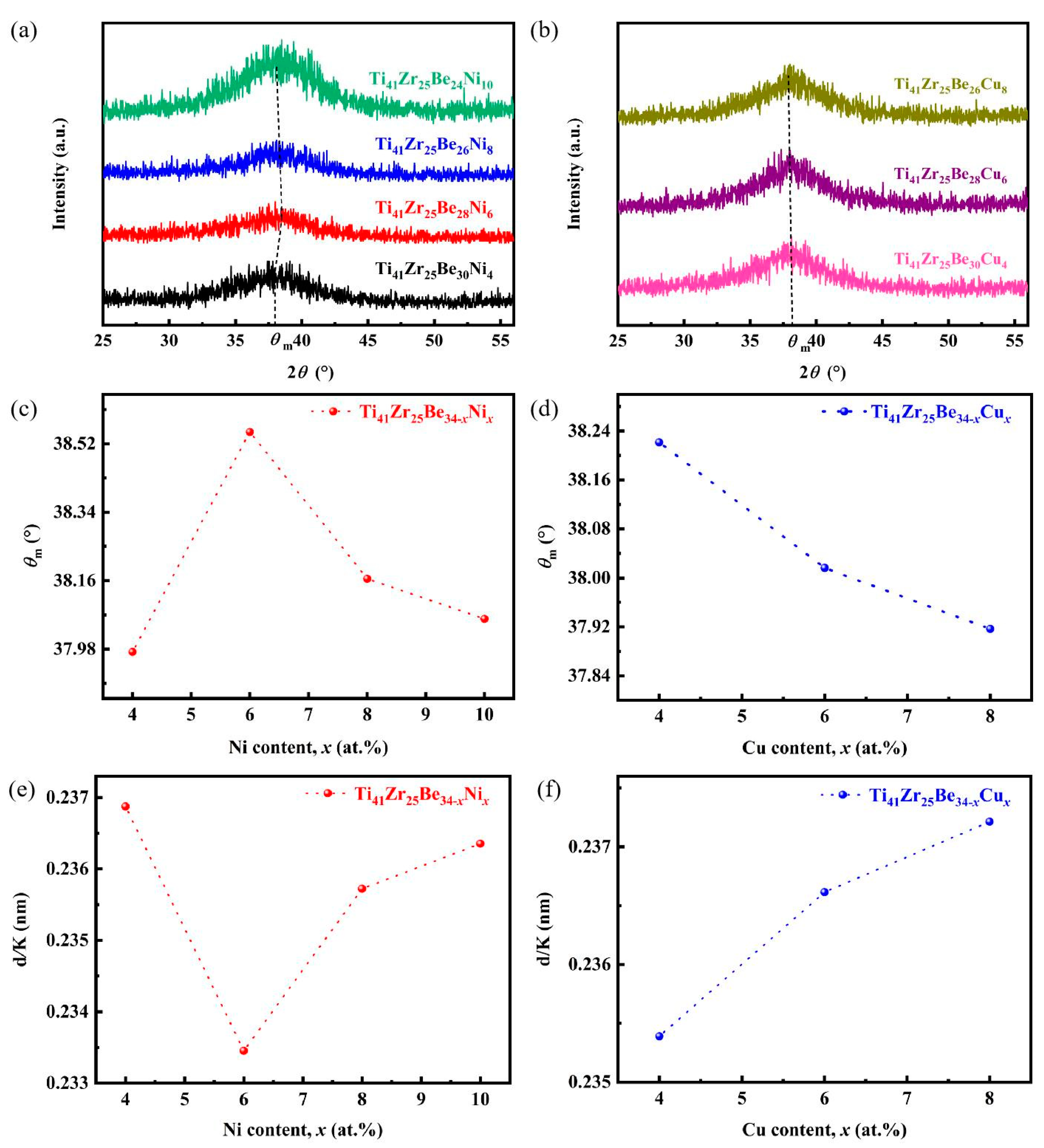Effect of Chemical Composition on the Thermoplastic Formability and Nanoindentation of Ti-Based Bulk Metallic Glasses
Abstract
:1. Introduction
2. Experimental Materials and Methods
3. Results
3.1. Amorphous Nature
3.2. Thermoplastic Formability
3.3. Viscosity
3.4. Nanoindentations
4. Discussion
5. Conclusions
- The viscosity of Ti-based BMGs exhibited a gradual decrease of several orders of magnitude with increasing temperature in the SCLR, and the TPF is influenced by both the viscosity and the width of the SCLR. In Ti41Zr25Be34-xNix BMGs, the TPF decreased with increasing Ni content, and Ti41Zr25Be30Ni4 exhibited the highest TPF compared with the other alloys due to its wider SCLR and lower values of viscosity in the SCLR. Conversely, for Ti41Zr25Be34-xCux BMGs, the TPF was enhanced with increasing Cu content, reaching its peak at 8 at.% Cu (Ti41Zr25Be26Cu8). This result is similarly ascribed to its wider SCLR and lower viscosity in the SCLR.
- The nanoindentation tests reveal that the hardness and modulus of Ti41Zr25Be34-xNix BMGs exhibited an initial increase followed by a decrease with increasing Ni content. Specifically, at 6 at.% Ni, the highest values of hardness (7.26 GPa) and modulus (125.8 GPa) were observed. Furthermore, the hardness and modulus of Ti41Zr25Be34-xCux decreased with increasing Cu content. At 4 at.% Cu, the alloy demonstrated the maximum values of hardness (7.27 GPa) and modulus (126.2 Gpa) among the Ti41Zr25Be34-xCux BMGs. In this study, based on Bragg’s law, the position of the maximal diffracted intensity θm was utilized to reflect the mean atomic distance, suggesting the variation in atomic density. This indicates the varying tendency of the hardness of Ti-based BMGs.
Author Contributions
Funding
Institutional Review Board Statement
Informed Consent Statement
Data Availability Statement
Conflicts of Interest
References
- Wang, T.; Zhou, Y.; Zhang, L. Chemical and structural heterogeneity improve the plasticity of a Zr-based bulk metallic glass at low-temperature annealing. J. Non-Cryst. Solids 2023, 603, 122115. [Google Scholar] [CrossRef]
- Ruschel, L.M.; Adam, B.; Gross, O.; Neuber, N.; Frey, M.; Wachter, H.-J.; Busch, R. Development and optimization of novel sulfur-containing Ti-based bulk metallic glasses and the correlation between primarily crystallizing phases, thermal stability and mechanical properties. J. Alloys Compd. 2023, 960, 170614. [Google Scholar] [CrossRef]
- Shao, L.; Ketkaew, J.; Gong, P.; Zhao, S.; Sohn, S.; Bordeenithikasem, P.; Datye, A.; Mota, R.M.O.; Liu, N.; Kube, S.A.; et al. Effect of chemical composition on the fracture toughness of bulk metallic glasses. Materialia 2020, 12, 100828. [Google Scholar] [CrossRef]
- Nomoto, K.; Ceguerra, A.V.; Gammer, C.; Li, B.; Bilal, H.; Hohenwarter, A.; Gludovatz, B.; Eckert, J.; Ringer, S.P.; Kruzic, J.J. Medium-range order dictates local hardness in bulk metallic glasses. Mater. Today 2021, 44, 48–57. [Google Scholar] [CrossRef]
- Zhang, T.; Long, Z.; Peng, L.; Li, Z. Prediction of glass forming ability of bulk metallic glasses based on convolutional neural network. J. Non-Cryst. Solids 2022, 595, 121846. [Google Scholar] [CrossRef]
- Deng, Y.; Wang, C.; Ding, F.; Zhang, T.; Wu, W. Thermo-mechanical coupled flow behavior evolution of Zr-based bulk metallic glass. Intermetallics 2023, 152, 107770. [Google Scholar] [CrossRef]
- Li, N.; Pan, J.; Liu, Z.; Liu, L. Metallic glass nanostructures: Forming strategies and functional applications. Mater. Today Adv. 2022, 15, 100253. [Google Scholar] [CrossRef]
- Zhang, M.; Wang, Y.; Ding, G.; Zheng, R.; Wei, R.; Zhang, G.; Sun, Q.; Zhao, X.; Liu, L. Biocompatible superhydrophobic surface on Zr-based bulk metallic glass: Fabrication, characterization, and biocompatibility investigations. Ceram. Int. 2023, 49, 25549–25562. [Google Scholar] [CrossRef]
- Gu, J.; Shao, Y.; Shi, L.; Si, J.; Yao, K. Novel corrosion behaviours of the annealing and cryogenic thermal cycling treated Ti-based metallic glasses. Intermetallics 2019, 110, 106467. [Google Scholar] [CrossRef]
- Du, P.; Xiang, T.; Cai, Z.; Xie, G. The influence of porous structure on the corrosion behavior and biocompatibility of bulk Ti-based metallic glass. J. Alloys Compd. 2022, 906, 164326. [Google Scholar] [CrossRef]
- Tang, Y.L.; Zhang, T.W.; Shi, X.H.; Qiao, J.W.; Wang, Z.H.; Zhou, H.F.; Wu, Y.C. Design novel Ti-based metallic glass matrix composites with excellent dynamic plasticity. J. Alloys Compd. 2019, 773, 844–852. [Google Scholar] [CrossRef]
- Li, H.F.; Zheng, Y.F. Recent advances in bulk metallic glasses for biomedical applications. Acta Biomater. 2016, 36, 1–20. [Google Scholar] [CrossRef] [PubMed]
- Gu, J.-L.; Shao, Y.; Zhao, S.-F.; Lu, S.-Y.; Yang, G.-N.; Chen, S.-Q.; Yao, K.-F. Effects of Cu addition on the glass forming ability and corrosion resistance of Ti-Zr-Be-Ni alloys. J. Alloys Compd. 2017, 725, 573–579. [Google Scholar] [CrossRef]
- Nishiyama, N.; Amiya, K.; Inoue, A. Novel applications of bulk metallic glass for industrial products. J. Non-Cryst. Solids 2007, 353, 3615–3621. [Google Scholar] [CrossRef]
- Liens, A.; Etiemble, A.; Rivory, P.; Balvay, S.; Pelletier, J.-M.; Cardinal, S.; Fabrègue, D.; Kato, H.; Steyer, P.; Munhoz, T.; et al. On the Potential of Bulk Metallic Glasses for Dental Implantology: Case Study on Ti40Zr10Cu36Pd14. Materials 2018, 11, 249. [Google Scholar] [CrossRef] [PubMed]
- Ma, X.; Li, Q.; Chang, L.; Chang, C.; Li, H.; Sun, Y. Enhancement on GFA and mechanical properties of Ni-based bulk metallic glasses through Fe addition. Intermetallics 2017, 90, 58–62. [Google Scholar] [CrossRef]
- Men, H.; Pang, S.; Inoue, A.; Zhang, T. New Ti-Based Bulk Metallic Glasses with Significant Plasticity. Mater. Trans. 2005, 46, 2218–2220. [Google Scholar] [CrossRef]
- Kai, W.; Kao, P.C.; Chen, W.S.; Lin, C.L.; Xiao, Z.H.; Hsu, C.F.; Lee, P.Y. The oxidation behavior of a Ti50Cu28Ni15Sn7 bulk metallic glass at 400–500 °C. J. Alloys Compd. 2010, 504, S180–S185. [Google Scholar] [CrossRef]
- Wu, X.F.; Suo, Z.Y.; Si, Y.; Meng, L.K.; Qiu, K.Q. Bulk metallic glass formation in a ternary Ti–Cu–Ni alloy system. J. Alloys Compd. 2008, 452, 268–272. [Google Scholar] [CrossRef]
- Zhang, X.F.; Kim, K.B.; Yi, S. Effects of Co on the microstructures and mechanical properties of Ti50Cu50−xCox alloys (x = 0–25 at.%). Philos. Mag. Lett. 2010, 90, 43–50. [Google Scholar] [CrossRef]
- Hao, G.J.; Lin, J.P.; Zhang, Y.; Chen, G.L.; Lu, Z.P. Ti–Zr–Be ternary bulk metallic glasses correlated with binary eutectic clusters. Mater. Sci. Eng. A 2010, 527, 6248–6250. [Google Scholar] [CrossRef]
- Guo, F.; Wang, H.-J.; Poon, S.J.; Shiflet, G.J. Ductile titanium-based glassy alloy ingots. Appl. Phys. Lett. 2005, 86, 091907. [Google Scholar] [CrossRef]
- Zhao, S.; Chen, N.; Gong, P.; Yao, K. Centimeter-Sized Quaternary Ti-Based Bulk Metallic Glasses with High Ti Content of 50 at%: Centimeter-Sized Quaternary Ti-Based Bulk Metallic. Adv. Eng. Mater. 2016, 18, 231–235. [Google Scholar] [CrossRef]
- Zhao, S.F.; Shao, Y.; Gong, P.; Yao, K.F. A Centimeter-Sized Quaternary Ti-Zr-Be-Ag Bulk Metallic Glass. Adv. Mater. Sci. Eng. 2014, 2014, 192187. [Google Scholar] [CrossRef]
- Zhao, S.F.; Gong, P.; Li, J.F.; Chen, N.; Yao, K.F. Quaternary Ti–Zr–Be–Ni bulk metallic glasses with large glass-forming ability. Mater. Des. 2015, 85, 564–573. [Google Scholar] [CrossRef]
- Zhao, S.F.; Chen, N.; Gong, P.; Yao, K.F. New centimeter-sized quaternary Ti–Zr–Be–Cu bulk metallic glasses with large glass forming ability. J. Alloys Compd. 2015, 647, 533–538. [Google Scholar] [CrossRef]
- Gong, P.; Li, F.; Jin, J. Preparation, Characterization, and Properties of Novel Ti-Zr-Be-Co Bulk Metallic Glasses. Materials 2020, 13, 223. [Google Scholar] [CrossRef] [PubMed]
- Gong, P.; Wang, X.; Shao, Y.; Chen, N.; Yao, K. Ti-Zr-Be-Fe quaternary bulk metallic glasses designed by Fe alloying. Sci. China Phys. Mech. Astron. 2013, 56, 2090–2097. [Google Scholar] [CrossRef]
- Tang, M.Q.; Zhang, H.F.; Zhu, Z.W.; Fu, H.M.; Wang, A.M.; Li, H.; Hu, Z.Q. TiZr-base Bulk Metallic Glass with over 50 mm in Diameter. J. Mater. Sci. Technol. 2010, 26, 481–486. [Google Scholar] [CrossRef]
- Zhang, L.; Tang, M.Q.; Zhu, Z.W.; Fu, H.M.; Zhang, H.W.; Wang, A.M.; Li, H.; Zhang, H.F.; Hu, Z.Q. Compressive plastic metallic glasses with exceptional glass forming ability in the Ti–Zr–Cu–Fe–Be alloy system. J. Alloys Compd. 2015, 638, 349–355. [Google Scholar] [CrossRef]
- Calin, M.; Gebert, A.; Ghinea, A.C.; Gostin, P.F.; Abdi, S.; Mickel, C.; Eckert, J. Designing biocompatible Ti-based metallic glasses for implant applications. Mater. Sci. Eng. C 2013, 33, 875–883. [Google Scholar] [CrossRef]
- Zhang, C.; Ouyang, D.; Pauly, S.; Liu, L. 3D printing of bulk metallic glasses. Mater. Sci. Eng. R Rep. 2021, 145, 100625. [Google Scholar] [CrossRef]
- Li, Z.; Huang, Z.; Sun, F.; Li, X.; Ma, J. Forming of metallic glasses: Mechanisms and processes. Mater. Today Adv. 2020, 7, 100077. [Google Scholar] [CrossRef]
- Schroers, J. On the formability of bulk metallic glass in its supercooled liquid state. Acta Mater. 2008, 56, 471–478. [Google Scholar] [CrossRef]
- Hasan, M.; Schroers, J.; Kumar, G. Functionalization of Metallic Glasses through Hierarchical Patterning. Nano Lett. 2015, 15, 963–968. [Google Scholar] [CrossRef]
- Gong, P.; Kou, H.; Wang, S.; Deng, L.; Wang, X.; Jin, J. Research on thermoplastic formability and nanomoulding mechanism of lightweight Ti-based bulk metallic glasses. J. Alloys Compd. 2019, 801, 267–276. [Google Scholar] [CrossRef]
- Cai, F.-F.; Sarac, B.; Chen, Z.; Czibula, C.; Spieckermann, F.; Eckert, J. Surmounting the thermal processing limits: Patterning TiZrCuPdSn bulk metallic glass even with nanocrystallization. Mater. Today Adv. 2022, 16, 100316. [Google Scholar] [CrossRef]
- Cai, F.-F.; Blanquer, A.; Costa, M.B.; Schweiger, L.; Sarac, B.; Greer, A.L.; Schroers, J.; Teichert, C.; Nogués, C.; Spieckermann, F.; et al. Hierarchical Surface Pattern on Ni-Free Ti-Based Bulk Metallic Glass to Control Cell Interactions. Small 2023. early view. [Google Scholar] [CrossRef]
- Liu, Z.; Schroers, J. General nanomoulding with bulk metallic glasses. Nanotechnology 2015, 26, 145301. [Google Scholar] [CrossRef]
- Bordeenithikasem, P.; Shen, Y.; Tsai, H.-L.; Hofmann, D.C. Enhanced mechanical properties of additively manufactured bulk metallic glasses produced through laser foil printing from continuous sheetmetal feedstock. Addit. Manuf. 2018, 19, 95–103. [Google Scholar] [CrossRef]
- Pitt, E.B.; Kumar, G.; Schroers, J. Temperature dependence of the thermoplastic formability in bulk metallic glasses. J. Appl. Phys. 2011, 110, 043518. [Google Scholar] [CrossRef]
- Schroers, J. Processing of Bulk Metallic Glass. Adv. Mater. 2010, 22, 1566–1597. [Google Scholar] [CrossRef] [PubMed]
- Kawamura, Y.; Nakamura, T.; Inoue, A. Superplasticity in Pd40Ni40P20 metallic glass. Scr. Mater. 1998, 39, 301–306. [Google Scholar] [CrossRef]
- Zhang, W.; Tao, P.; Chen, Y.; Si, J.; Long, Z.; Huang, S.; He, H.; Huang, Z.; Yang, Y. Structural evolutionary behavior of Zr-based bulk metallic glasses under thermoplastic deformation. Intermetallics 2023, 155, 107831. [Google Scholar] [CrossRef]
- Hu, Q.; Fu, M.W.; Zeng, X.R. Thermostability and thermoplastic formability of (Zr65Cu17.5Ni10Al7.5)100−xREx (x = 0.25–3.25, RE: Y, Gd, Tb, Dy, Ho, Er, Tm, Yb, Lu) bulk metallic glasses. Mater. Des. 2014, 64, 301–306. [Google Scholar] [CrossRef]
- Turnbull, D. Under What Cond. Can A Glass Be Form? Contemp. Phys. 1969, 10, 473–488. [Google Scholar] [CrossRef]
- Lu, Z.P.; Liu, C.T. A new glass-forming ability criterion for bulk metallic glasses. Acta Mater. 2002, 50, 3501–3512. [Google Scholar] [CrossRef]
- Kumar, G.; Tang, H.X.; Schroers, J. Nanomoulding with amorphous metals. Nature 2009, 457, 868–872. [Google Scholar] [CrossRef] [PubMed]
- Zhang, W.; Miao, H.; Li, Y.; Chang, C.; Xie, G.; Jia, X. Glass-forming ability and thermoplastic formability of ferromagnetic (Fe, Co, Ni)75P10C10B5 metallic glasses. J. Alloys Compd. 2017, 707, 57–62. [Google Scholar] [CrossRef]
- Parthiban, R.; Stoica, M.; Kaban, I.; Kumar, R.; Eckert, J. Viscosity and fragility of the supercooled liquids and melts from the Fe–Co–B–Si–Nb and Fe–Mo–P–C–B–Si glass-forming alloy systems. Intermetallics 2015, 66, 48–55. [Google Scholar] [CrossRef]
- Stoica, M.; Ramasamy, P.; Kaban, I.; Scudino, S.; Nicoara, M.; Vaughan, G.B.M.; Wright, J.; Kumar, R.; Eckert, J. Structure evolution of soft magnetic (Fe36Co36B19.2Si4.8Nb4)100−xCu (x= 0 and 0.5) bulk glassy alloys. Acta Mater. 2015, 95, 335–342. [Google Scholar] [CrossRef]
- Pi, J.; Wang, Z.; He, X.; Bai, Y.; Zhen, R. Nanoindentation mechanical properties of glassy Cu29Zr32Ti15Al5Ni19. J. Alloys Compd. 2016, 657, 726–732. [Google Scholar] [CrossRef]
- Haag, F.; Beitelschmidt, D.; Eckert, J.; Durst, K. Influences of residual stresses on the serrated flow in bulk metallic glass under elastostatic four-point bending—A nanoindentation and atomic force microscopy study. Acta Mater. 2014, 70, 188–197. [Google Scholar] [CrossRef]
- Schuh, C.A.; Nieh, T.G. A nanoindentation study of serrated flow in bulk metallic glasses. Acta Mater. 2003, 51, 87–99. [Google Scholar] [CrossRef]
- Concustell, A.; Sort, J.; Alcalá, G.; Mato, S.; Gebert, A.; Eckert, J.; Baró, M.D. Plastic Deformation and Mechanical Softening of Pd40Cu30Ni10P20 Bulk Metallic Glass During Nanoindentation. J. Mater. Res. 2005, 20, 2719–2725. [Google Scholar] [CrossRef]
- Oliver, W.C.; Pharr, G.M. An improved technique for determining hardness and elastic modulus using load and displacement sensing indentation experiments. J. Mater. Res. 1992, 7, 1564–1583. [Google Scholar] [CrossRef]
- Borie, B. X-ray Diffraction in Crystals, Imperfect Crystals, and Amorphous Bodies. J. Am. Chem. Soc. 1965, 87, 140–141. [Google Scholar] [CrossRef]
- Hufnagel, T.C.; Brennan, S. Short- and medium-range order in (Zr70Cu20Ni10)90−xTaxAl10 bulk amorphous alloys. Phys. Rev. B 2003, 67, 014203. [Google Scholar] [CrossRef]
- Caron, A.; Wunderlich, R.; Louzguine-Luzgin, D.V.; Xie, G.; Inoue, A.; Fecht, H.-J. Influence of minor aluminum concentration changes in zirconium-based bulk metallic glasses on the elastic, anelastic, and plastic properties. Acta Mater. 2010, 58, 2004–2013. [Google Scholar] [CrossRef]
- Bera, S.; Ramasamy, P.; Şopu, D.; Sarac, B.; Zálešák, J.; Gammer, C.; Stoica, M.; Calin, M.; Eckert, J. Tuning the glass forming ability and mechanical properties of Ti-based bulk metallic glasses by Ga additions. J. Alloys Compd. 2019, 793, 552–563. [Google Scholar] [CrossRef]
- Yang, W.; Li, J.; Liu, H.; Dun, C.; Zhang, H.; Huo, J.; Xue, L.; Zhao, Y.; Shen, B.; Dou, L.; et al. Origin of abnormal glass transition behavior in metallic glasses. Intermetallics 2014, 49, 52–56. [Google Scholar] [CrossRef]
- Sharma, S.; Suryanarayana, C. Effect of Nb on the glass-forming ability of mechanically alloyed Fe–Ni–Zr–B alloys. Scr. Mater. 2008, 58, 508–511. [Google Scholar] [CrossRef]
- Lv, J.W.; Yin, D.W.; Wang, F.L.; Yang, Y.J.; Ma, M.Z.; Zhang, X.Y. Influence of sub-Tg annealing on microstructure and crystallization behavior of TiZr-based bulk metallic glass. J. Non-Cryst. Solids 2021, 565, 120855. [Google Scholar] [CrossRef]






| Composition | Tg (K) | Tx (K) | ΔTx (K) | Tm (K) | Tl (K) | Trg | ΔHm (J g−1) | S |
|---|---|---|---|---|---|---|---|---|
| Ti41Zr25Be30Ni4 | 601 | 684 | 83 | 876 | 1118 | 0.5380 | −22.29 | 0.1605 |
| Ti41Zr25Be28Ni6 | 597 | 680 | 83 | 868 | 1108 | 0.5388 | −34.37 | 0.1624 |
| Ti41Zr25Be26Ni8 | 591 | 655 | 64 | 874 | 1050 | 0.5629 | −33.23 | 0.1394 |
| Ti41Zr25Be24Ni10 | 595 | 654 | 59 | 864 | 1041 | 0.5716 | −26.23 | 0.1323 |
| Ti41Zr25Be30Cu4 | 579 | 669 | 90 | 870 | 1120 | 0.5169 | −25.95 | 0.1664 |
| Ti41Zr25Be28Cu6 | 590 | 674 | 84 | 881 | 1119 | 0.5273 | −35.22 | 0.1588 |
| Ti41Zr25Be26Cu8 | 578 | 673 | 95 | 885 | 1093 | 0.5288 | −27.00 | 0.1845 |
Disclaimer/Publisher’s Note: The statements, opinions and data contained in all publications are solely those of the individual author(s) and contributor(s) and not of MDPI and/or the editor(s). MDPI and/or the editor(s) disclaim responsibility for any injury to people or property resulting from any ideas, methods, instructions or products referred to in the content. |
© 2024 by the authors. Licensee MDPI, Basel, Switzerland. This article is an open access article distributed under the terms and conditions of the Creative Commons Attribution (CC BY) license (https://creativecommons.org/licenses/by/4.0/).
Share and Cite
Chen, M.; Zhu, L.; Chen, Y.; Dai, S.; Liu, Q.; Xue, N.; Li, W.; Wang, J.; Huang, Y.; Yang, K.; et al. Effect of Chemical Composition on the Thermoplastic Formability and Nanoindentation of Ti-Based Bulk Metallic Glasses. Materials 2024, 17, 1699. https://doi.org/10.3390/ma17071699
Chen M, Zhu L, Chen Y, Dai S, Liu Q, Xue N, Li W, Wang J, Huang Y, Yang K, et al. Effect of Chemical Composition on the Thermoplastic Formability and Nanoindentation of Ti-Based Bulk Metallic Glasses. Materials. 2024; 17(7):1699. https://doi.org/10.3390/ma17071699
Chicago/Turabian StyleChen, Mengliang, Liu Zhu, Yingwei Chen, Sheng Dai, Qijie Liu, Na Xue, Weiwei Li, Jinfang Wang, Yingqi Huang, Kaice Yang, and et al. 2024. "Effect of Chemical Composition on the Thermoplastic Formability and Nanoindentation of Ti-Based Bulk Metallic Glasses" Materials 17, no. 7: 1699. https://doi.org/10.3390/ma17071699






